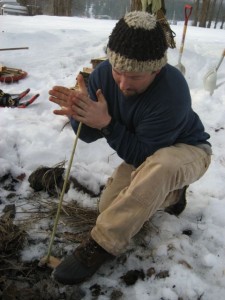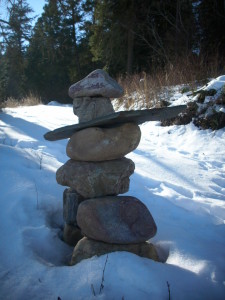As a child it amazed me the way my father could navigate in the woods. It also amazed me that he could go the whole day without having to go to the bathroom, but that is another story! We could head out on a trip, whether for a few hours or a few days, with our backpacks and fishing gear, and after some solid immersion time and a lot of twists and turns, pick a beeline to the vehicle and walk out of the forest within 50 yards of where we started. He was magic!
As the years went by he began to teach me how he did it, and not surprisingly most of being able to navigate instinctively boils down to common sense and awareness. Here are a few simple things you can do to find your way in the woods without the aid of your GPS or search and rescue.
Memorize the Map: I know you are thinking, “Wait a minute, I thought this was about ‘instinctive’ navigation!” It is, but you need to have an idea of where you are headed before you head out. Get a good map of the area, orient it and study the topography. Study it from the direction you will enter the area and visualize where the sun will be and where the landmarks are. Take a look of the area on the computer utilizing a satellite imagery program such as Google Maps. Note any lakes, waterways and tributaries, the orientation of mountain ranges or other geological features to the cardinal points of the compass. Take a look at your possible routes and visualize in your mind what you think you might see when you are there. When I take the time to do these things I find that I feel much less need to refer to the map during a trip, and it goes a long way to making a new area feel familiar.
Use your visualization skills while you are hiking: If you have taken the time to study an area before entering, as you move through that area visualize and picture your location on the map from above. For those who grew up playing video games, this may sound somewhat familiar. Many adventure games have a mini-map in a corner or at the bottom which shows your character’s general location. With some practice it will become unnecessary to keep this visualization in the forefront of your thoughts; it can fade to the back and be called up if needed.
A couple of years ago I was a leader on a trip to the Bob Marshall Wilderness in Montana. This was my first time in that area, and I had studied available resources before the trip. We had been in the area several days fishing and hiking and had gotten used to the topography, and for our final day of fishing we decided to head north and fish a different tributary. We left base camp by one trail, and on the way back we decided to avoid fording the river and hiking in wet shoes (read: whiny scouts) back to camp by traveling a trail new to all of our party. Although there were 2 others in our group that were familiar with the area, I found myself leading the hike. It happens. After several miles on this new trail my gut feelings began to tell me that if we went any further on this we would end up going a ways out of our way and we would have to hike up a steep open ridge that I would rather avoid. We couldn’t really see the ridge yet. We were still in the aspens on a pleasant trail, but something kept nagging me to turn left and cut cross country, so I did. The group followed, some with protest that we had left the trail and we would get lost, but after about 250 yards of the detour we came out on top of the ridge trail right above our camp. That short cross-country saved us nearly a mile of walking at the end of an already long day. My overhead visualizer had alerted me to a shortcut.
Turn Around: When moving through unfamiliar territory turn around every few hundred yards and look at the landscape from the other direction. Things often look very different from another direction, and this will make it familiar territory on your way out. Take special note of any landmarks both far and near. I was about 12 years old when my Dad taught me this trick. We were hiking into a new area in Yellowstone National Park and he kept turning around and just looking. At first I thought he was waiting for me to catch up, but I realized he wasn’t looking at me, and he wasn’t impatient. I finally asked what he was doing. He took the next quarter mile to show me as we headed down a ridge through trees. We stopped and looked from above, and when we got to lower ground we turned around and looked back. See photos 1 & 2 It DID look different! We left the trees and when we got to the creek that was our destination we turned around to look at the treeline and mark our location of entry. After fishing our way to our left for several hours we took a rough beeline across the open country to the woods. Once we were in the trees, roughly where we had exited earlier, he tested me, letting me pick the route back to the vehicle. Because we had turned around on our way in to look at things, the area was familiar enough to find the way easily. We did find a big pile of grizzly bear scat on the way out that wasn’t there on the way in, but that is another story…
Build Trail Markers: sometimes navigation can be difficult even if you are familiar with the area. The landscape can be monotonous, or weather events such as a snowstorm can change the look of the land in a matter of hours. Piles of stones, or a cairn, every so often can be a huge help when finding your way back. A fallen log out of place or stood on end can sometimes work. It doesn’t have to be much, but you want something big enough to see from a ways off without being too obtrusive, and sturdy enough to survive weather changes. See photo 3 for an example.
A few other general tips: Pay attention to growth patterns in vegetation present. Note what it looks like on sunny areas vs. shady areas, wet vs. dry, etc. Each general area will have its patterns that are easily recognizable and can alert you if you are headed in the wrong direction. Watch the sun, general weather directions, typical wind patterns, stars, sunrise and set, etc. It sounds ridiculous, but if the sun is rising in the west it’s time to re-orient yourself. It happens. Notice prevailing winds and normal weather conditions. A change in the wind does not always indicate that you are turned around, but if the reliable afternoon southwest breeze is coming from the northeast, you are probably disoriented.
Stay conscious at all times, and periodically stop and recon a beeline from your current location back to your starting point. This can be especially useful if you are engaged in activities such as hunting or fishing, wildcrafting, mushroom hunting, or any other engrossing activity where your attention is directed downward. I spent time with a friend in a small section of forest hunting Chanterelle mushrooms one fall. We were only out for an hour, but after he had said we needed to return to the car he headed off in the exact opposite direction. “Where are you going?” I asked. “To the car.” He replied with confidence. “Not YOUR car.” I said, and I headed off the other way. He protested, but his confidence faltered and he soon followed. He offered to bet me that I was disoriented, but I didn’t have the heart to take him for anything. Minutes later we walked out of the woods in view of the vehicle.
In Summary: accurate navigation by instincts is often an innate ability that some folks are just born with, but I do believe that most people can learn to do it through a combination of study and preparation, awareness, visualization and practice, practice, practice. Learning new areas and cutting cross country (in places that allow it) can be fun and in some cases it can save some distance walking. However make no mistake; this article is not advocating entering an area unprepared! Carry a map, compass and all the tools you will need to prevent yourself from needing your friends at Search and Rescue. It’s always easier to know where you at all times than to try and find out where you might be!
 Patrick Farneman grew up in the school of the outdoors backpacking, fishing and hiking, and he also has more formal education than he cares to admit sometimes. He has been practicing the skills of our ancestors for nearly 30 years, and has been teaching them at workshops and international gatherings for over 15 years. He is proficient with many of the old skills and crafts. Patrick is a founding board member of Bridges to the Past, a non-profit organization dedicated to bringing people together through ancestral skills, cultural and environmental awareness. He has a deep love for his family, the outdoors & the environment, and a thirst for adventure. For more information please visit the Bridges to the past website at: www.bridgestothepast.org and for comments feel free to email Patrick at: patrickf@bridgestothepast.org
Patrick Farneman grew up in the school of the outdoors backpacking, fishing and hiking, and he also has more formal education than he cares to admit sometimes. He has been practicing the skills of our ancestors for nearly 30 years, and has been teaching them at workshops and international gatherings for over 15 years. He is proficient with many of the old skills and crafts. Patrick is a founding board member of Bridges to the Past, a non-profit organization dedicated to bringing people together through ancestral skills, cultural and environmental awareness. He has a deep love for his family, the outdoors & the environment, and a thirst for adventure. For more information please visit the Bridges to the past website at: www.bridgestothepast.org and for comments feel free to email Patrick at: patrickf@bridgestothepast.org





2 Responses to Instinctive Navigation: Keeping the ‘Dead’ out of Dead Reckoning by Patrick Farneman